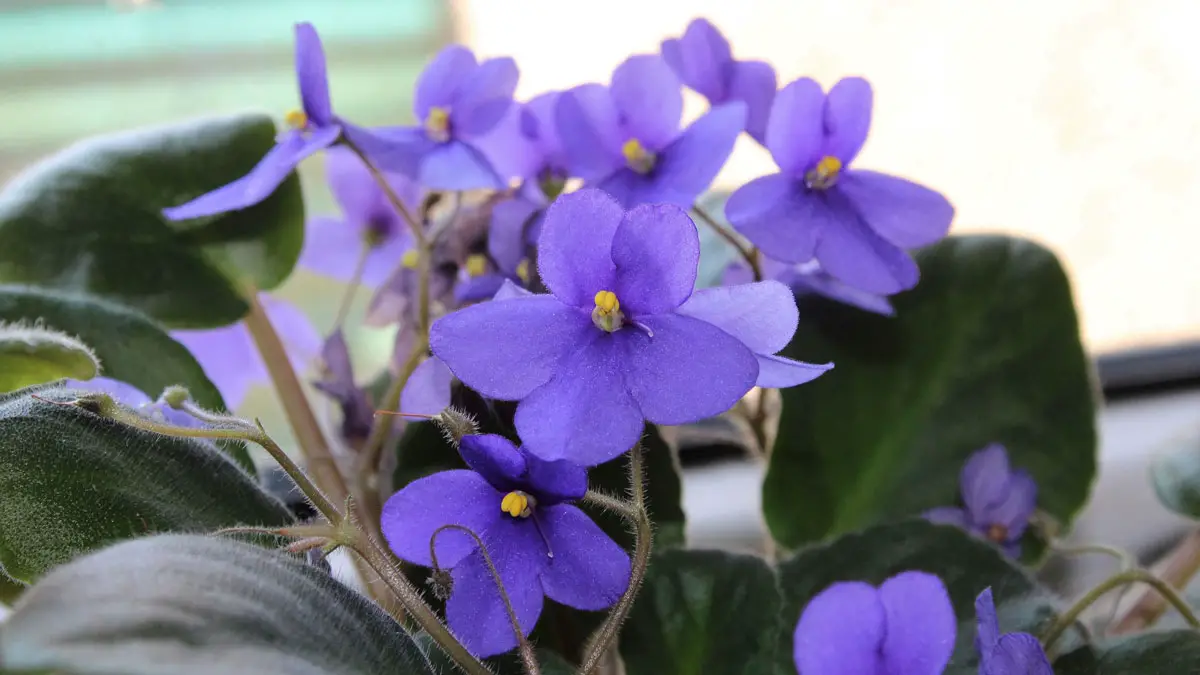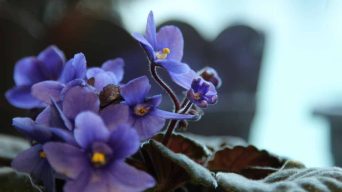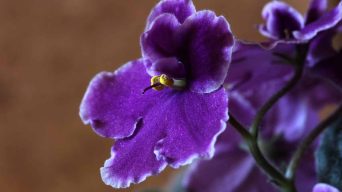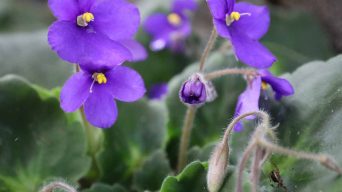African violets need bright, indirect sunlight to bloom. Lack of sunlight is the most common reason they don’t flower. Too much sun can burn the leaves. Other factors affecting flowering include improper watering, fertilizer problems, and incorrect temperature conditions.
African violets are cherished for their vibrant, colorful blooms that can bring natural beauty to any indoor space.
However, it can be disheartening when your African Violet doesn’t seem to bloom as expected.
Several factors could cause this issue, and understanding them is crucial for bringing life back into your plant’s blossoming display.
In this blog post, we’ll explore the common reasons African violets may not bloom, such as insufficient light or improper care practices, and offer solutions to help your beloved houseplant thrive again.
Common Reasons Why African Violets May Not Bloom
African violets are beloved houseplants known for their vibrant blooms and delicate appearance.
However, even with proper care, these plants may sometimes refuse to bloom, leaving their owners puzzled and disappointed.
Here we explore the most common reasons African violets may fail to produce blooms, ranging from environmental factors to pests and diseases.
Understanding these causes can help you troubleshoot and provide your plant with the conditions to thrive and blossom.
Lack Of Adequate Light
A key factor influencing the blooming of African violets is the availability of adequate light.
These tropical plants thrive under bright indirect light, which helps to stimulate flowering and maintain healthy foliage.
Insufficient sunlight exposure can lead to various issues, most notably, a lack of blooms or poorly developed flowers.
To ensure your African Violet receives optimal lighting conditions, position them near a brightly lit window while avoiding direct sunlight exposure since it may cause leaf burn or even hinder blooming altogether.
You might also consider using artificial sources such as fluorescent lights or LED grow lights for at least 10-12 hours per day if natural sources are insufficient in your space.
Inadequate Temperature
Inadequate temperature is a primary factor hindering your African Violet from blooming.
These vibrant houseplants thrive in a consistent temperature range of 60 to 80 degrees Fahrenheit, making regulating their environment crucial for proper growth and flowering.
To maintain an optimal temperature for your African violets, keep them away from drafty windows, vents, or doors where they might be exposed to sudden changes or extreme temperatures.
Consider using a thermometer near the plants’ location to monitor conditions accurately.
During colder months or in an area with low outdoor temperatures, consider utilizing heat mats specifically designed for indoor plants, as they help regulate soil temperature without overheating the foliage.
Incorrect Watering
Incorrect watering is a common reason why African Violets may not bloom.
Ensuring the proper hydration for these delicate plants requires paying close attention to their specific needs and adjusting your care routine accordingly.
For example, overwatering can harm the plant’s health by suffocating its fine roots with excess moisture, making it difficult for air to penetrate the soggy soil mass.
To strike the right balance, it’s essential to keep your African Violet’s soil consistently moist without oversaturating it or allowing it to dry out completely between waterings.
Learning how each plant responds best can sometimes entail trial and error through methods such as bottom-watering (placing a small amount of water in a saucer under the pot) or top-watering using lukewarm distilled water carefully poured directly onto the soil surrounding violet leaves.
Be sure not to wet foliage during watering as this could lead to disease or leaf rot issues that will negatively impact blooming.
Low Humidity
One of the common reasons why African violets may not bloom is low humidity.
When the air around your plant is too dry, it can cause the leaves to become dry and brittle, which hinders the plant’s ability to produce blooms.
Additionally, low humidity can cause the soil to dry out too quickly, leading to a lack of nutrients and moisture for your plants, thus causing them not to bloom.
You can increase humidity around your plants by placing a tray filled with water near your plants or using a humidifier in smaller spaces.
Incorrect Pot Size
Choosing the wrong pot size for your African Violet can impact its ability to bloom.
Selecting an appropriately sized pot that allows room for growth without being too large is essential.
When choosing a new pot, consider the size of your plant and aim for a container just slightly larger than its current one.
Typically, a 4-6 inch pot is enough space for most African violets to thrive.
Additionally, ensure the pot has drainage holes on the bottom to prevent water buildup at the roots.
Nutrient Imbalances
One of the common reasons why African violets may not bloom is nutrient imbalances.
These can occur when the plant receives too much or too little fertilizer, leading to a deficiency or toxicity of certain plant nutrients.
For example, excess nitrogen could cause the leaves to grow excessively while hindering flowering.
Fortunately, this issue can be addressed using a balanced fertilizer formulated for African violets.
It’s important to follow the instructions carefully and avoid overfertilization as it can burn the roots and damage the plant.
Pest Infestations
Pest infestations are one of the most common problems that can cause your African Violet to stop blooming.
Several pests, including aphids, spider mites, and thrips, commonly attack these plants.
These insects suck the sap from the leaves and stems of your plants, causing yellowing and stunting of growth.
One simple solution is to place a few banana peels in the potting mix around your African Violet.
The potassium in bananas acts as a natural pesticide by repelling pests such as aphids and spider mites.
Diseases
Unfortunately, African violets are susceptible to various diseases, including powdery mildew and root rot.
Powdery mildew is caused by fungal spores that thrive in humid conditions and can affect the leaves, making them appear distorted or covered in a white, powdery substance.
Root rot occurs when the plant’s roots decay due to overwatering or poor drainage.
To prevent these diseases from affecting your African Violet’s blooming potential, it’s essential to maintain proper watering habits and ensure the soil stays moist but not saturated.
Additionally, providing adequate airflow around the plant can help deter fungal growth.
If you notice signs of disease on your African Violet, promptly isolate the plant from other indoor plants and treat accordingly using an appropriate fungicide or insecticide spray.
Solutions To Encourage Blooming In African Violets
Growing African violets can be a rewarding experience, but it can also be frustrating if they fail to bloom.
Fortunately, several solutions can help encourage the production of delicate, vibrant flowers.
From ensuring that your violets receive the right amount of light and water, to addressing any pest issues, following these simple steps can help you achieve the beautiful blooms you desire.
Here we will explore how you can encourage blooming in African violets and keep them healthy and thriving.
Provide Optimal Light
To encourage blooming in your African violets, providing them with the right amount of light is important.
Here are some ways to achieve optimal light conditions for your plant:
- Place your African Violet in a bright spot with indirect sunlight. Direct sunlight may scorch the leaves and prevent blooming.
- Ensure your Violet gets at least 12-14 hours of bright indirect light daily. Lack of adequate light is one of the main reasons why African violets don’t bloom.
- If you don’t have enough natural light, consider using fluorescent grow lights or LED lights designed for indoor plants. Position the lights about 6-8 inches above the top of the plant.
- Rotate your violet pot periodically to ensure all sides get equal amounts of light.
- Avoid placing your African Violet near cold windows or drafty areas, as this can cause temperature fluctuations that affect growth and blooming.
Maintain Proper Temperature
Maintaining proper temperature is crucial for encouraging blooming in African violets.
Here are some tips to help you maintain the right temperature for your plant:
- Keep your plant away from drafty windows, doors, or air conditioning vents, as sudden changes in temperature can affect the blooms.
- The ideal temperature range for African violets is between 18°C and 24°C during the day and slightly cooler at night, around 16°C to 20°C.
- Use a thermometer to monitor the ambient temperature around your plant.
- If temperatures fluctuate significantly in your home, consider using a grow light to provide consistent warmth for your African Violet.
Water Correctly
Watering African violets the right way is crucial to getting them to bloom.
Here’s what you need to know:
- Always use room temperature water when watering African violets.
- Water the soil, not the leaves or flowers. Leaves and flowers get damaged easily when they get wet.
- Be sure not to overwater your plant – this common mistake can prevent it from blooming. Let the soil around the roots dry out before watering again to avoid overwatering.
- When it’s time to water, pour water into the top of the pot slowly until it starts coming out of the drainage hole at the bottom. This ensures that all of the soil gets evenly moistened.
- Never let your African Violet sit in standing water – this can lead to root or crown rot, harming your plant.
Increase Humidity
Maintaining proper humidity levels is crucial in encouraging blooming in African violets.
Here are some ways to increase humidity for your plants:
- Group your African violets together: Placing your African violet plants close to each other can help create a higher humidity environment around them.
- Use a tray of water: Placing your plant pots on top of a tray filled with pebbles and water can help increase the humidity level in the air around them.
- Use a humidifier: You can also use a humidifier to maintain the ideal humidity level for your African violet plants.
- Cover pots with plastic wrap: Another way to increase humidity for your African violets is by covering them with plastic wrap, which helps keep moisture in the soil and provides an enclosed space for the plant to thrive.
Remember that low humidity levels can cause African violets to lose more water than they absorb, leading to dryness and a reduction in blooming.
Choose The Right Pot Size
Selecting the proper pot size is crucial for African violets to bloom.
Here are some tips on how to choose the perfect pot:
- Measure the diameter formed by the outer edge of the plant’s leaves, and select a pot that is 1/3 of that measurement in width.
- Avoid oversized pots, as they can cause the soil to retain too much moisture, leading to root rot and fewer blooms.
- Small pots should also be avoided since they can limit growth, resulting in smaller leaves and less flowering.
- Using a shallow pot with drainage holes at the bottom is best to promote air circulation and prevent stagnant water from damaging roots.
- African violets prefer plastic or ceramic pots instead of clay ones as they retain more moisture, leading to root rot and stagnant water.
Remember that going up a pot size is not necessary for your African Violet to bloom; it’s all about selecting a pot that promotes healthy growth and blooming conditions.
Fertilize Appropriately
African violets require adequate fertilization for healthy growth and blooming.
Here are some tips for fertilizing appropriately:
- Use a balanced fertilizer: Choose a fertilizer with equal amounts of nitrogen, phosphorous, and potassium (NPK). A balanced fertilizer will promote healthy foliage, roots, and flowers in African violets.
- Fertilize regularly: Apply the fertilizer every 2-4 weeks during the growing season (spring and summer) to encourage blooming. Reduce the frequency to once a month during fall and winter when the plant is dormant.
- Dilute the fertilizer: Always dilute the fertilizer to half-strength or less before applying it to your African Violet. Too much fertilizer can burn the delicate roots of the plant.
- Apply at the base: Pour the diluted fertilizer solution directly onto the soil surrounding your African Violet rather than its leaves, as it can cause damage.
- Consider using organic fertilizers: Organic fertilizers like compost, worm castings, or fish emulsion are mild on plants and improve soil health over time.
Address Pest Infestations
Pest infestations can cause damage to the leaves and flowers of African violets, preventing them from blooming.
Here are some tips on how to address pest infestations:
- Identify the type of pest: Different pests require different treatments. Common pests that affect African violets include aphids, spider mites, mealybugs, and thrips.
- Isolate affected plants: If you find an infested plant, immediately isolate it from other plants to prevent the spread of pests.
- Use natural remedies: Use natural remedies such as neem oil or insecticidal soap to treat mild pest problems.
- Use chemical treatments as a last resort: If the infestation is severe, consider using chemical treatments such as systemic insecticides. However, use these products with caution and follow the instructions carefully.
- Regularly inspect your plants: Regularly inspect your African violets for signs of pest activity so that you can identify and treat a problem early on.
Treat Diseases
If your African Violet is not blooming, it might be because of diseases.
Here are the common diseases that could affect your African Violet and how to treat them:
- Powdery Mildew: Powdery mildew appears on the leaves as a white powdery substance. To treat this, remove diseased leaves and mist the rest with water mixed with baking soda or fungicide spray.
- Root Rot: Root rot happens when overwatering causes the roots to rot. Let the soil dry out before watering again, and repot your plant in fresh soil to fix this.
- Crown Rot: Crown rot is caused by fungi attacking the base of the plant’s stem. To treat this, cut away infected areas and disinfect the tools used.
- Rust Disease: Rust disease appears as rust-colored spots on leaves and can be treated with fungicide.
- Bacterial Blight: Bacterial blight looks like dark, water-soaked lesions on leaves and can be treated by cutting away diseased parts of the plant and treating them with bactericides.
Remember always to isolate any affected plants to prevent the spreading of diseases throughout your collection!
Final Thoughts
African violets are beautiful houseplants that require proper care to bloom.
Lack of light is the most common reason for their failure to bloom.
Other factors include inadequate warmth, watering, soil conditions, pest infestations, and diseases.
Fortunately, solutions are available to encourage blooming in African violets, such as providing optimal light and temperature conditions, watering correctly, fertilizing appropriately, increasing humidity levels, and choosing the right pot size.







